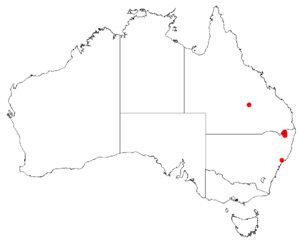Persoonia daphnoides facts for kids
Quick facts for kids Persoonia daphnoides |
|
|---|---|
| Scientific classification | |
| Genus: |
Persoonia
|
| Species: |
daphnoides
|
 |
|
| Occurrence data from Australasian Virtual Herbarium | |
Persoonia daphnoides is a special plant that belongs to the Proteaceae family. It is found only in a small area near the border of New South Wales and Queensland in Australia. This plant is a low-growing shrub with unique leaves and yellow flowers. It is endemic to this area, meaning it naturally grows nowhere else in the world.
Contents
What Does Persoonia daphnoides Look Like?
Persoonia daphnoides is a shrub that grows very close to the ground. It usually reaches a height of about 10 centimeters (4 inches). Its young branches are covered with light brown hairs.
Leaves and Flowers
The leaves of this plant are shaped like a spatula or an egg. They are narrower at the bottom. Each leaf is about 15 to 50 millimeters (0.6 to 2 inches) long and 4 to 20 millimeters (0.2 to 0.8 inches) wide. They are often twisted sideways.
The bright yellow flowers grow in groups of up to eight. They are found along a central stem called a rachis, which can be up to 35 millimeters (1.4 inches) long. After flowering, this stem often grows into a leafy shoot.
Each flower sits on a short, upright stalk called a pedicel, about 1.5 to 3 millimeters long. The flower parts, called tepals, are yellow and measure about 9 to 10 millimeters (0.35 to 0.4 inches) long. They are hairy on the outside. This plant usually blooms from December to January.
How Was Persoonia daphnoides Named?
The plant Persoonia daphnoides was first officially described in 1830. A famous botanist named Robert Brown wrote about it. He used notes from another botanist, Allan Cunningham. Brown's description was published in a book called Supplementum primum Prodromi florae Novae Hollandiae.
Cunningham had noted that he found the plant near the "Hunter's River." However, later experts, Peter H. Weston and Lawrie Johnson, believe this location might have been a mistake.
Where Does Persoonia daphnoides Grow?
This type of geebung (a common name for Persoonia plants) grows in woodlands and forests. You can find it near the towns of Tenterfield in New South Wales and Stanthorpe in Queensland. It prefers higher places, growing at altitudes between 950 and 1200 meters (3,100 to 3,900 feet) above sea level.

